 |
|

|
 |
TABLE of CONTENTS
 |
Bridge inspectors adjust to COVID-19 restrictions to ensure safety of state's structures |
By Mike Dougherty, District 6 public engagement and communications director

Josh Thiemann, non-redundant steel tension member inspection team, listens to an inspector up in a snooper truck on the Winona Bridge in June. Photo by Mike Dougherty |
The time of COVID-19 has been one of adjustment, but the work of MnDOT hasn't stopped.
For MnDOT's bridge inspection teams, the need to evaluate the state's bridges is ongoing. In District 6 alone, MnDOT has 990 bridges scheduled for inspection this year for both the district and local agencies. That includes two of its fracture critical Mississippi River Bridges - Wabasha (Hwy 60) and Winona (Hwy 43), which were inspected last month.
The inspection process requires teams and aerial equipment such as the snooper trucks. Their multi-jointed arms allow inspectors to maneuver out from a bridge and under it to ensure they can get close to inspect areas that need evaluation.
Teams need to limit exposure to each other, so the traditional method of having two people in a snooper basket has been changed. In the past, the work of the duo is similar to something you might have during a dental checkup with the dentist inspecting your teeth and gums and calling out measurements to an assistant who records it.
Now, one inspector is in the basket and the person who records the inspection observations is elsewhere, either in another vehicle or along the shoreline of the river. Another operator is in the snooper monitoring the movements by video. All are tied in by radio to communicate.

Scott Theisen, non-redundant steel tension member inspection team, inspects a portion of the Winona Bridge in June. Photo by Mike Dougherty |
"We've all adjusted," said Tom Miles, District 6 bridge safety inspection engineer. "The biggest thing is only one inspector in a basket and using cameras and a spotter on the ground to ensure safety."
In the end, they are adjustments for safety, something all MnDOT teams are accustomed to doing depending on conditions and circumstances. Teams in the field are following the guidance for limiting exposure in vehicles and heightened measures for cleaning and disinfecting equipment, vehicles and high-touch areas after usage. It does create additional steps, but MnDOT is committed to reducing and limiting the spread of COVID-19.
"The COVID19 pandemic has required MnDOT to innovate and improve our bridge inspection safety process," said Ed Lutgen, bridge construction and maintenance engineer, who works out of the statewide Bridge Office in Oakdale. "Looking beyond the current health situation, some of the safety improvements, including the technological and communication protocols, will remain to protect employees. Sometimes short-term challenges can create long-term opportunities."
|
| |
|

|
 |
TABLE of CONTENTS
 |
MnDOT assists local agencies in response to Twin Cities' unrest |
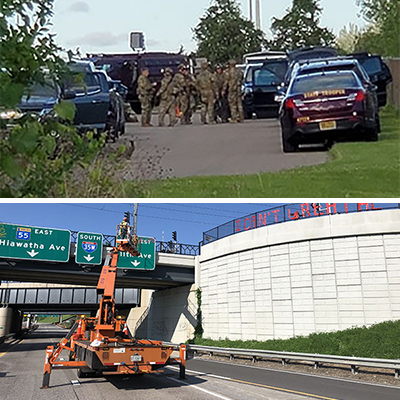
More than 100 MnDOT employees provided support during the unrest following the death of George Floyd at the hands of Minneapolis police officers. MnDOT workers were called on to assist with multiple efforts to keep Minnesotans safe and protect their right to protest systemic racism. Metro District maintenance staff helped set up J-wall and jersey barriers and assisted with traffic control and clean-up efforts. In addition, about 125 National Guard members bunked at the Cedar Avenue truck station per 12-hour shift during the operation.
MnDOT's Training Center in Shoreview also served as a staging area for an estimated 1,000 people from multiple agencies, including the Minnesota State Patrol, Bureau of Criminal Apprehension, Ramsey County Sheriff, National Guard, Department of Natural Resources, Metro Transit and Salvation Army. Training Center staff immediately switched their focus from building improvement projects to providing onsite services and ongoing facility and grounds cleanup, according to Linda Hinrichs, Workforce Development manager.
Top photo by Ben Sargent; bottom photo by Kevin Swecker |
|
 |
|

|
 |
TABLE of CONTENTS
 |
Coordination helps agencies deliver oversize/overweight cargo safely to its destination |
By Kristi Schadegg, Office of Freight and Commercial Vehicle Operations
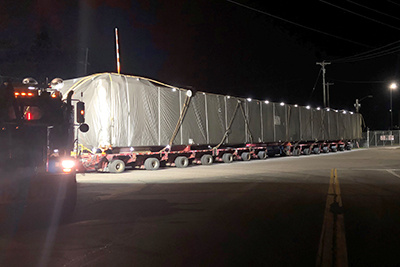
Because of the extreme size and weight of this cold box, weighing more and measuring longer than the largest airplane in the world, Barnhart Crane and Rigging transported this cold box at night to minimize traffic impacts during the day. Photo submitted by Barnhart Crane and Rigging |
When Barnhart Crane and Rigging first reached out to the Oversize/Overweight Permits unit in the Office of Freight and Commercial Vehicle Operations in April, they said they needed to move something big ... really big!
Their cargo: nine cold boxes, used to process refrigerated liquid products (such as oxygen, nitrogen and argon) that operate at extreme cold temperatures for cryogenic storage. All nine components varied in size, with the largest measuring 20 feet wide, almost 20 feet high, more than 250 feet long, and weighing 623,904 pounds. This is longer and heavier than an Airbus A380-800, the largest airliner in the world.
The journey of these cold boxes began in New Orleans, where they were loaded on a barge and shipped up the Mississippi River, off-loaded near Inver Grove Heights, and transported to their final destination in Cottage Grove. Though there were only about 16 miles to travel from Inver Grove Heights to the facility, the complexity of the route and the size of these extreme loads required six hours to transport, and special coordination between the Oversize/Overweight Permits unit, Metro District, the driver, Barnhart Crane and Rigging, the State Patrol and the utility company.
Due to low hanging power lines, the height of the largest loads, and a roundabout which couldn't be navigated easily, these extreme loads needed to use the opposite side of the road at two specific locations.
Barnhart worked with Metro District and the State Patrol to set up message boards and traffic control for these wrong-way maneuvers, which required closing the road temporarily. To minimize the inconvenience to motorists, Barnhart transported the load at night when traffic volumes are low.
Though it was complex and challenging to move these cold boxes such a short distance, teamwork and coordination between MnDOT and partners made it possible for these loads to reach their destination, ensuring the safety of motorists - and without knocking down any power lines in the process.
|
| |
|

|
 |
TABLE of CONTENTS
 |
Study shows benefits of public transit exceed costs in rural, small urban areas |
A recent study commissioned by the Office of Transit and Active Transportation shows the benefits of rural and small urban transit services exceed the costs of providing the services. For every dollar spent to provide transit services in Greater Minnesota, benefits worth $2.51 are shared throughout the communities, according to the “Measuring the Economic Benefits of Rural and Small Urban Transit Services in Greater Minnesota” report.
“Transit systems are often viewed as valuable community assets, but the value of those services was unmeasured,” said Noel Shughart, transit team planning leader in the Office of Transit and Active Transportation who was on the study’s technical advisory panel. “Identifying those services and placing a value on them helps us understand how vital they are to the well-being of the communities.”
The study included a survey that shows a third of the riders who use transit to get to work said they would not be able to keep their jobs if they couldn’t use transit. Providing and improving access to work reduces spending on public assistance that would be needed to support people who are unemployed.
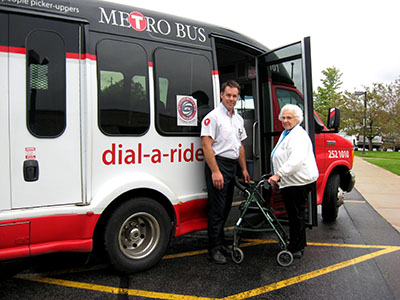
MnDOT administers state and federal transit assistance funds for more than 40 transit systems in Greater Minnesota. Pictured is the Dial-a-Ride service in St. Cloud. Submitted photo
|
Transit helps people get to their health care appointments for preventative services, which reduces emergency care visits. There is a broader benefit when people traveling to their appointments can rely more on transit and less on their family and friends, who often take time off work to provide transportation, the study reported.
Transit riders also have access to nearby businesses, contributing to increased spending and economic activity close to home.
“Without transit, some of those shopping trips would not be made and local spending would be lost,” Shughart said. “Transit allows people to live where they want to and that keeps people living and working in small communities.”
The study included case studies and information about transit systems across the state. Altogether, Minnesotans received mobility and efficiency benefits valued at $271 million. Health care benefits made up the largest part of that amount at $228 million.
The study noted that transit provides intangible benefits that are harder to measure, including supporting independent living, allowing seniors to age in place, improving quality of life and improving social opportunities for all ages, abilities and incomes.
North Dakota State University and Montana State University conducted the study.
The study can be found on the Research and Innovation website. |
| |
|

|
 |
TABLE of CONTENTS
 |
Redeployment stories: MnDOT staff assist Health, FEMA |
By Joseph Palmersheim
Editor's note: This is a continuation in our series about MnDOT employees who have found themselves temporarily reassigned to jobs at other state agencies to help respond to the COVID-19 pandemic.

Jed Falgren is on a partial redeployment to the Minnesota Department of Health's Logistics Workstream Group. He is pictured here in his home office. Submitted photo |
Jed Falgren contributes to 'Minnesota Moonshot' team at MDH
Jed Falgren, Transportation Systems Management and Operations director, is currently on a partial redeployment to the Minnesota Department of Health's Logistics Workstream Group. This partial redeployment, done via telework, allows him to continue working in a limited role at TSMO. His reassignment started in April.
"I was surprised, but happy to step in and help in any way I could," Falgren said. "I enjoy complex logistic challenges that are time sensitive."
MDH's Logistics Workstream Group is a collection of doctors, lab managers, IT specialists, supply chain managers and others at Mayo Clinic, the University of Minnesota, Fairview Health and the state of Minnesota. The group's work consists of setting up the systems and procedures that are a part of the "Minnesota Moonshot" testing goal Gov. Tim Walz announced in April.
"This partnership is working to dramatically increase the available testing capacity across Minnesota," Falgren said. "Bringing all of the right things together at the right time is a huge challenge. Not only are we talking about the lab equipment to run the tests, but you also need the right equipment, like swabs, PPE and reagents. And none of this works if you don't have the people to complete all of these steps. One of the large, behind-the-scenes challenges that we work on is information flow. There are well over 50 data points for each sample that must be tracked throughout the process. The largest challenge is automating the transfer of that data between systems that don't normally talk together."
Falgren also sits in on the Testing Command Center meetings three times a week, where up to 75 people from all health organizations that are involved in testing share information to build a more solid testing system.
"It is amazing to experience up close to see the public and private sectors working together to help manage our response to COVID-19," Falgren said. "We have a long way to go and improvements yet to make, but seems that at least the right people who can make a difference are talking routinely. Personally, I find it fun to be working in an area where I am not familiar with. At times, I only know enough to ask the 'dumb question.' When I do, either I get smarter by learning or the group sees an issue from a different perspective that might aid in developing solutions."
Jennifer Hoffman assists MDH with purchasing inventory
Jennifer Hoffman, a buyer in MnDOT's Purchasing section, has been performing similar duties at the Department of Health since April 15 as part of the state's COVID-19 response.
"I was surprised to be redeployed," she said. "I have been assigned Alternative Care Facilities purchasing, which is part of the governor's COVID-19 work groups. That portion of my new role has been interesting. I have also been processing solicitations for MDH, doing a lot of purchasing for the labs related to COVID-19. They are keeping me very busy."
The transition has involved "an entirely new learning process," she said, as MDH does things differently than MnDOT.
"I have had to learn and get familiar with those programs very quickly," Hoffman said. "I have been fortunate to have been placed in a work group of people who have been very welcoming and friendly. It has been interesting to see how differently the two agencies do things as well as being involved with the fight against COVID-19."
Erin Meier helps state agencies navigate FEMA reimbursement
Erin Meier, principal planner in Emergency Management, has been redeployed part-time to two state agencies. In addition to working 50 percent of her normal time at MnDOT, she divides the rest of her time between the Department of Human Services and the Department of Health. Her reassignments started on May 27.
Thanks in part to its work with debris cleanup and protective measures like sandbagging during severe weather and flooding, MnDOT is no stranger to FEMA reimbursement, which is part of Meier's regular job duties. MDH and DHS are not normally involved in FEMA reimbursement after a natural disaster, so they don't have experience with FEMA, Meier said. She is working with people in both agencies' finance departments to set up projects in FEMA's online portal, training them on how to enter information on the projects. She also has been answering questions about how FEMA works and what types of activities would be FEMA eligible.
"I'm glad I'm able to help," Meier said. "While we pursue FEMA reimbursement pretty often, Health and DHS don't, and they were feeling overwhelmed. Having someone to talk through what they are doing and answer questions seems to be helping a lot."
Check out our first and second reassignment stories from previous editions of Newsline.
|
 |
|

|
 |
TABLE of CONTENTS
 |
On the Job: Carolyn Adamson manages Metro District projects from scoping to construction |
By Rich Kemp
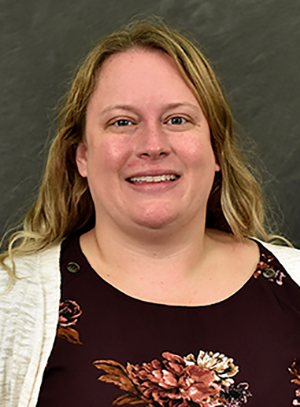
Photo by Rich Kemp |
Carolyn Adamson is the Metro District lead project manager. She has been at MnDOT for 11 years. She started in water resources and has worked in project management the last four years.
What do you do in your job?
I am a project manager for design projects that are to be constructed in the next five years. I manage teams of functional area representatives and consultants to complete design projects that fulfill the project scope and meet the schedule and budget requirements. I also coordinate with outside stakeholders to inform them of upcoming projects, gather their needs and incorporate their input when possible.
What is your favorite part about your job? Seeing a project go from scoping through letting and into construction. It is rewarding to see meaningful improvements made to our system in order to better serve the general public.
What are the biggest challenges?
Managing competing priorities can be a challenge. Through the course of a project there are many opinions on what the best product is and they don't always agree. Finding a way to resolve the differences is one of my biggest challenges.
What kind of changes have you seen in your job?
I have seen more of an emphasis on working with the public. The more we can engage with the users of our system the better product we can deliver.
Do you or a co-worker have an interesting job to share with readers? Send us your ideas, and we'll contact you for more information.
Recent employee profiles:
|
 |
|

|
 |
TABLE of CONTENTS
 |
Bridge lighting celebrates Class of 2020 |
|
The Interstate 35W Bridge in Minneapolis displayed the colors of Minnesota high schools the evenings of June 25-26, as a tribute to the graduating Class of 2020. There were 86 two-color combinations changing every five minutes during the lighting, which lasted from 30 minutes before sunset until 30 minutes after sunrise the next day.
“The global pandemic put an abrupt halt to many cherished traditions and activities this spring, including graduation ceremonies celebrating the hard work of thousands of Minnesota high school seniors,” Commissioner Margaret Anderson Kelliher said. “We’re lighting the bridge to honor the achievements of these students and the promise they bring for a brighter tomorrow.”
Video by Joel Wenz |
|
 |
|

|
 |
TABLE of CONTENTS
 |
State Fair public information project wins government communications award |
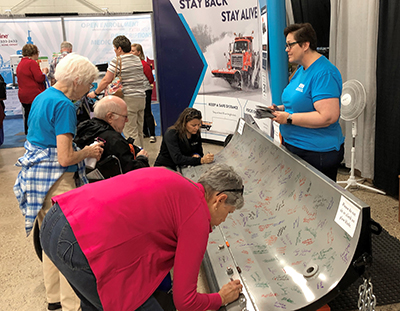
Commissioner Margaret Anderson Kelliher chats with visitors at MnDOT’s State Fair Booth Aug. 28, 2019. Members of the public were encouraged to sign the wing blade (and follow it on social media) as part of a public information effort that garnered a Northern Lights 2020 Silver Award from the Minnesota Association of Government Communicators. Photo by Rich Kemp |
MnDOT's Communications team recently won a Northern Lights 2020 Silver Award for public information from the Minnesota Association of Government Communicators. Because of COVID-19 restrictions, winners were announced via a Facebook live ceremony June 17.
MnDOT's winning entry, "Sharpies and Steel Engagement," centered on employees connecting with visitors to the agency's booth during the 2019 Minnesota State Fair. Thousands of people stopped by over the 12-day event to chat about transportation issues and sign their name and hometown on a snowplow wing blade. Maintenance crews later put those blades to work during the 2019-20 winter, and the public was encouraged to follow "their blade" on MnDOT's social media.
"Engagement doesn't happen without teamwork," said Anne Meyer, Office of Communications program administrator and project manager for this effort. "The communications team came up with the idea and put the plan into action, but a lot of work behind the scenes helped make this project a success."
Among those contributing were James Grebenc and his crew at Central Shop, who provided the wing blades and coordinated their distribution; Mike Waters and the welding team at the Maple Grove Truck Station, who created the steel stand to safely support the blades at the state fair booth; and Kevin Bergstedt in fleet, who put in extra hours to move new wing blades in and out of the fairgrounds while the fair was closed overnight.
"It was not an easy task, but our teams worked together to create this memorable and engaging fair experience," Meyer said. "We're hoping to build on its success in 2021, when the State Fair resumes."
Five blades were signed by the end of the fair. Two stayed in the Metro District and the others were sent to truck stations in districts 1, 7 and 8.
|
 |
|
| |
|



